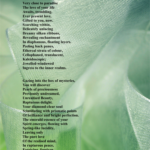…..and other acrobatic antics in the garden
Picture the scene – it’s late spring, and outside my window, hanging on the end of a cane attached to the roof of the conservatory is a bird feeder. It’s that type of solid pudding or cake, meant for small birds such a great tits and blue tits, who have been feeding there since winter.
The rather Heath Robinson means of suspension is somewhat complex in order to deter the ever present voracious squirrels who were so desperate to reach it they even attempted to scale the slippery glazing bars surrounding the windows. Lacking crampons or suitably formed claws, they failed – and their surprised look as they slid down the outside of the window was highly amusing. Observing those squirrels as they circled, pondered, made vain attempts and kept on trying and devising new routes was a valuable lesson in persistence.
It also reminded me of this wonderful TV programme some years ago when even the most complicated methods of keeping squirrels away from food failed, and the acrobatic audacity of the creatures was portrayed with hilariously entertaining results.
We’ve added deterrents to keep off starlings and blackbirds, and this little food supply is nourishing several families of birds. The tits themselves are no mean acrobats; their aeronautic feats are really quite breathtaking. They fly in at breakneck speed, stop suddenly – just short of splattering themselves onto the glass; at the same time they turn themselves upside down and hang onto the feeder with their feet, whilst staying ever alert to potential threats from predators – truly impressive stuff.
We have had some wonderful entertainment and inspiration watching the to-ing and fro-ing, and pondered on the sheer physical effort required to nurture a nest of chicks to fledgling status.
Recently, there have been territorial wars and thrilling examples of adaptability and determination. Enter our common garden friend, the Robin. Ever present whenever we are out in the garden raking leaves or turning over earth, they grab grubs in their inimitable opportunistic way, bold, alert and happy to sing for their supper.
The robins observed that the tits were very messy eaters – they left behind lots of scraps, probably at least half of what they peck off drops onto the ground beneath the feeder. Initially, the robins simply cleaned up the scraps on the floor. Then they became dissatisfied and wanted to control the food supply.
Slight problem – their spindly legs and larger body weight do not naturally lend themselves to performing the feats of inversion and gripping at which the tits are so expert. A fly-past peck doesn’t do the trick of dislodging the food.
What to do?
New approach – the robins attack the tits whenever they alight on the feeder – but only after they have filled their beaks – causing the tits to disgorge the food onto the floor and enabling the wily robins to clean up the spoils.
Next, the robins decide that they are spending too much time waiting for the tits to turn up and serve dinner.
What to do now?
It appears that robins have very strong wings. So they ingeniously decide to adopt the hovering method. Expending huge amounts of energy, they flap their wings, humming-bird fashion, at great speed, maintaining themselves in position to be able to devour the food directly from source. It is a remarkable sight, the wings a blur as they flap furiously – and they return time after time, fiercely defending the feeder, so the tits are having to dive in at the moments when the robins are back at the nest feeding their young. Other birds have got wise – pigeons, blackbirds and starlings congregate underneath and pick up the scraps, and the odd crazy blackbird seems to want to emulate the robin, and also pretends to be a humming bird.
Now the scenario outside my window is more peaceful again, and the Robin has reverted to waiting on the ground whilst the tits congregate on the feeder and scatter the food. The fledged blue tits accompany their parents, and though perfectly capable of feeding themselves, still willingly accept the thrusting beak inserting food into their throats.
It’s said evolution takes a long time, many generations; in this rapidly-moving world I’m beginning to think that adaptation is a much faster-paced affair, with enterprising creatures observing effective behaviours in other species, and adopting them quickly.
The Robin
- observed,
- experimented,
- acted,
- regrouped,
- strategised,
- repeated,
- refined,
- persevered and ultimately
- triumphed.
He gained control of the food supply for his family, in that intense period of requiring huge quantities to feed the growing chicks.
Hopefully we have begun a sustainable cycle which will see many families of birds return each year to rear their young, and provide us with ongoing lessons in flexibility and adaptation.
We can all learn a great deal from observing how nature adapts to ensure nurture.
Now how can YOU take these lessons in natural persistence, flexibility and adaptation and make the most of the opportunities in your life at this time?
© Christine Miller



